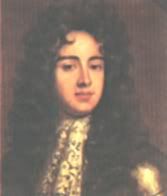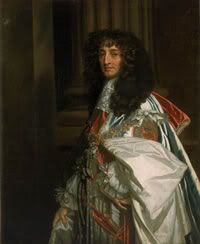Of cool historical English men (and pirates)
I am madly in love with The King’s Touch by Jude Morgan. It’s the best novel I’ve read in months. I am also fascinated because its protagonist is the Duke of Monmouth, and I’ve never read a book solely about him before. All I know about him are the very general facts: eldest illegitimate son of Charles II (and for all I know, the only one) who, after Charles died without any legitimate children and Charles’ brother James II ascended the throne, started a rebellion which was put down and the Duke was executed (must have made for an interesting family reunion that year). Of course, James himself was wildly unpopular and kicked out for William and Mary some time later. I do have to say that I’ve known about Monmouth a lot longer than I did about most English historical figures because his rebellion is the event that lands Peter Blood on the slave docks and later leads to piracy, and I read and adored Sabatini’s Captain Blood, since I was 9 or so (and developed a quite irrational dislike of James II ever since), as Blood, even though he does not participate in the rebellion, gets dragged in as a rebel because as a physician he was helping a wounded man and tried under one of those huge sham trials James did after the rebellion.
Here is a portrait of the guy. According to wikipedia, rather gruesomely, following his execution, it was realised only too late that there was no official portrait of the Duke - for someone who had claimed the throne, albeit in vain, this was unheard of. So his body was exhumed, the head placed back on the body, and it was sat for its portrait to be painted.

Anyway, whatever the real Duke of Monmouth was, I am quite in a fictional crush state on his literary counterpart in the novel. And reading this book actually made me remember and locate another novel about a secondary figure in English history, The Stranger Prince by Margaret Irwin, about Prince Rupert who really had one of those legendary crazy lives you wouldn’t believe happened if it wasn’t fact. I read the book ages ago and loved it, even if it deals only with a small portion of the guy’s life.
Anyway, here is a completely random historical digression about Prince Rupert. He was the nephew of Charles I (and the Uncle of Charles II) who was the son of one of the Electors and Charles’ sister and fought in the Eighty Years War (talk about a nasty conflict) and was captured and imprisoned. Then he came over to Charles I’s court and when the Revolution broke out he was the leader of the Cavalier cavalry.
According to wikipedia, he is responsible for the cavaliers’ early military successes and his dashing reputation earned him the nickname of the “Mad Cavalier.” He reputedly took a large dog, a poodle named "Boye", into battle with him on several occasions. Throughout the Civil War the soldiers of Parliament feared this dog, claiming it had supernatural powers. He was appointed a general of the Royalist forces but later, when faced with an impossible situation Rupert surrendered Bristol, Charles dismissed him from his service. Rupert demanded a court-martial, which acquitted him.
For some time after this Rupert commanded the troops formed of English exiles in the French army. Then, following a degree of reconciliation with Charles, he obtained command of a Royalist fleet. However, following a naval defeat, Rupert took refuge in the West Indees where he follwed the life of a buccaneer, preying on English shipping. Pirates. Arrrrrrr.
Following the Restoration of the monarchy, Rupert accepted an annuity and became a member of the privy council. He never again fought on land, but turned admiral. He bore a brilliant part in the Second Anglo-Dutch War as actual supreme commander of the British fleet. However, his efforts in the Third Anglo-Dutch War met with humiliating failure.
After his retirement from the active military, he engaged in scientific research. Some have credited him with the invention of the mezzotint (whatever that is), which he introduced into England and developed new techniques for, as well as a form of gunpowder and an alloy named “Prince’s metal" in his honor. He is also credited with the invention of Prince Rupert’s Drops, glass teardrops which explode when the tail is cracked. Boy, the guy seems to have loved military violence...
Even in retirement he continued to hold important governmental posts (e.g. he served as Lord High Admiral) He did not marry but lived with a Drury Lane actress named Peg Hughes and had a daughter by her, named Ruperta.
Rupert became the first Governor of the Hudson’s Bay Company, which traded furs in Canada, and the territory of its immense trading monopoly gained the name Rupert’s Land for him. Prince Rupert, BC likewise takes its name from him.
ETA: Two portraits of Prince Rupert
Younger:

Older (and way better dressed. Hard to imagine this guy doing mad cavalry dashes or pirating because the outfit is sooooo stately):

Here is a portrait of the guy. According to wikipedia, rather gruesomely, following his execution, it was realised only too late that there was no official portrait of the Duke - for someone who had claimed the throne, albeit in vain, this was unheard of. So his body was exhumed, the head placed back on the body, and it was sat for its portrait to be painted.

Anyway, whatever the real Duke of Monmouth was, I am quite in a fictional crush state on his literary counterpart in the novel. And reading this book actually made me remember and locate another novel about a secondary figure in English history, The Stranger Prince by Margaret Irwin, about Prince Rupert who really had one of those legendary crazy lives you wouldn’t believe happened if it wasn’t fact. I read the book ages ago and loved it, even if it deals only with a small portion of the guy’s life.
Anyway, here is a completely random historical digression about Prince Rupert. He was the nephew of Charles I (and the Uncle of Charles II) who was the son of one of the Electors and Charles’ sister and fought in the Eighty Years War (talk about a nasty conflict) and was captured and imprisoned. Then he came over to Charles I’s court and when the Revolution broke out he was the leader of the Cavalier cavalry.
According to wikipedia, he is responsible for the cavaliers’ early military successes and his dashing reputation earned him the nickname of the “Mad Cavalier.” He reputedly took a large dog, a poodle named "Boye", into battle with him on several occasions. Throughout the Civil War the soldiers of Parliament feared this dog, claiming it had supernatural powers. He was appointed a general of the Royalist forces but later, when faced with an impossible situation Rupert surrendered Bristol, Charles dismissed him from his service. Rupert demanded a court-martial, which acquitted him.
For some time after this Rupert commanded the troops formed of English exiles in the French army. Then, following a degree of reconciliation with Charles, he obtained command of a Royalist fleet. However, following a naval defeat, Rupert took refuge in the West Indees where he follwed the life of a buccaneer, preying on English shipping. Pirates. Arrrrrrr.
Following the Restoration of the monarchy, Rupert accepted an annuity and became a member of the privy council. He never again fought on land, but turned admiral. He bore a brilliant part in the Second Anglo-Dutch War as actual supreme commander of the British fleet. However, his efforts in the Third Anglo-Dutch War met with humiliating failure.
After his retirement from the active military, he engaged in scientific research. Some have credited him with the invention of the mezzotint (whatever that is), which he introduced into England and developed new techniques for, as well as a form of gunpowder and an alloy named “Prince’s metal" in his honor. He is also credited with the invention of Prince Rupert’s Drops, glass teardrops which explode when the tail is cracked. Boy, the guy seems to have loved military violence...
Even in retirement he continued to hold important governmental posts (e.g. he served as Lord High Admiral) He did not marry but lived with a Drury Lane actress named Peg Hughes and had a daughter by her, named Ruperta.
Rupert became the first Governor of the Hudson’s Bay Company, which traded furs in Canada, and the territory of its immense trading monopoly gained the name Rupert’s Land for him. Prince Rupert, BC likewise takes its name from him.
ETA: Two portraits of Prince Rupert
Younger:

Older (and way better dressed. Hard to imagine this guy doing mad cavalry dashes or pirating because the outfit is sooooo stately):
